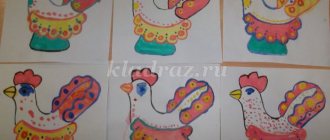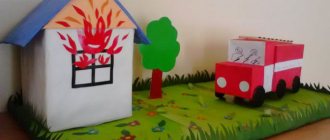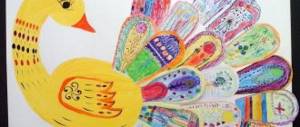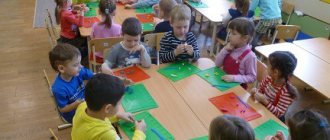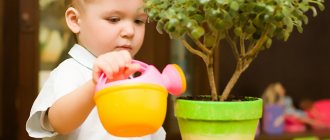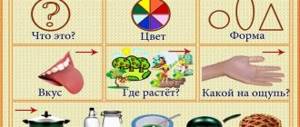Project in the middle group of a preschool educational institution. Dymkovo toy
Description : this project was developed for children of middle preschool age, it can be useful for kindergarten teachers. Project goal: Formation and development of the foundations of the spiritual and moral culture of children through familiarization with folk crafts - Dymkovo toys, painting.
Objectives: Educational: - To introduce the Dymkovo toy and the elements of Dymkovo painting. — To develop the skill of using drawing materials. — Teach to see the beauty of the Dymkovo toy. — Develop artistic taste as a result of making crafts.
Developmental: -Develop cognitive activity, visual memory, attention, curiosity. — Develop artistic taste as a result of making crafts. — Develop hand motor skills and fine finger movements. — Develop all components of coherent speech, its grammatical structure, dialogical speech, social and linguistic competence, and communication skills.
Educational: - To cultivate a love for folk crafts and folk art. — Cultivate respect for the work of masters.
Type of project : educational - creative.
Project duration : short-term
Project participants : teachers, parents, middle school children.
Relevance : The Dymkovo toy is a Russian folk toy that has firmly entered the everyday life of preschool institutions. It’s hard to imagine a more “childish” toy. Dymkovo toys attract children with their brightness and originality. These products delight the eye, lift your spirits, and reveal the world of a joyful holiday. Decorative drawings of Dymkovo toys are simple but original; they are naive but expressive. Decorative drawing of Dymkovo toys gives children the opportunity to feel themselves in the role of an artist - decorator, to reflect in their work an aesthetic vision and feeling of the beauty of the surrounding world and nature.
Expected result : during the implementation of this project, I assume that as a result of the joint activities of pupils, their parents and the group teacher, children will develop an interest in the Dymkovo toy. They will learn the colors of this painting and be able to name all its elements. Learn drawing techniques and learn how to make patterns. Children will get an initial understanding of decorative and applied arts and expand their horizons with the help of poems, riddles, and games. Parents of students will show interest in implementing the project and will use it at home.
Project implementation plan : 1. To interest people in Russian folk culture using the example of getting acquainted with the Dymkovo toy. 2. Preparatory stage: - Select and study literature about the history of the Dymkovo fishery and its current state.
— Creation of the necessary conditions for the implementation of the project. — Development and accumulation of methodological aids for getting acquainted with Dymkovo painting.
3. Main stage (practical): - Introduction into the educational process of effective methods and techniques for developing preschoolers’ knowledge about the Dymkovo toy. — Implementation of the project through various types of activities: holding conversations with children, reviewing manuals, artistic and creative activities, conducting didactic and board games, learning poems, nursery rhymes, guessing riddles on the topic.
4. Final. — Exhibition of drawings on the topic, crafts. -Organization of consultations for parents “The role of folk toys in the upbringing of preschoolers” - Organization of an exhibition of joint works of parents and children “The Beauty of the Haze”. — Quiz for parents and children “Dymkovo Toy Factory.”
Product of project activities: Didactic games, coloring books “Dymkovo toys”, replenishment of the Dymkovo toy collection, exhibition of handicrafts “The Beauty of Dymka”.
GCD. Cognition. Goal: To consolidate the ability to examine, describe and compare folk toys. To develop knowledge about the features of painting toys, color, and the main elements of the pattern. To cultivate interest, respect and respect for folk art.
1. Topic: “Introduction to the Dymkovo toy.” 2. Topic: presentation “Merry Haze”. 3. Topic: guess the riddle “Beautiful Haze.”
Communication. Purpose: Examination, comparison and description of objects. Formulating statements and independent judgments, drawing up proposals. React emotionally to the story, ask questions. 1. Topic: conversation “Features of painting Dymkovo toys.” 2. Topic: reading poems about the Dymkovo toy. 3. Topic: guessing riddles about Dymkovo toys. 4. Topic: learning poems about haze.
Artistic creativity. Purpose: Examination of Dymkovo toys, study of details and features of the ornament. Participate in a conversation about color and rhythm in a pattern. Completing the task according to the sample. Independent choice of color for the pattern and composing a pattern from familiar elements. Develop fine and gross motor skills of the hands. 1. Topic: “Dymkovo toy” (coloring with pencils according to the proposed sample). Coloring book of children's choice. 2. Topic: “Patterns of Dymkovo toys” (drawing some patterns with gouache). 3. Topic: “Decorating plates with Dymkovo patterns” (applique with drawing elements). 4. Topic: “Decorating a dress with Dymkovo patterns” (drawing).
Educational games. Goal: enrich children's vocabulary. Develop coherent speech, attention, thinking. Consolidate knowledge about the Dymkovo toy. 1. “Dymkovo Lotto”. 2. “Find the same pattern.” 3. “Assemble a pattern.” 4. “Put the whole thing together.”
Musical and artistic activities. Goal: to develop in children an interest in folk music and a desire to listen to it. Evoke emotional responsiveness. 1. L. Volokitina “Fair”. 2.Russian folk song “Berry”. 3. Russian folk song “Barynya”. 4. Russian folk song “We lived with grandma.” 5. Russian folk song “There was a birch tree in the field.”
Outdoor games. Goal: to introduce children to folk games. Develop the ability to act in a team. 1. "Stream". 2. "Burners". 3. “The shoes are lost.” 4. "Tug of war." 5. "Golden Gate".
Passport of the Dymkovo Toy project
Passport of the Dymkovo Toy project
Project type:
cognitive-creative, long-term.
Author of the project: Chernyshova Lyubov Vasilievna, teacher of the first qualification category, MKDOU "Novonikolaevsky kindergarten No. 1".
Project participants:
Pupils of the senior group, parents of pupils, teacher of the group.
Project duration:
2014-2015 academic year.
Relevance of the topic:
The history of folk toys begins in ancient times. It is connected with the creativity of the people, with folk art, with folklore. A toy is one of the most ancient forms of creativity; over the centuries it has changed along with the entire folk culture, absorbing its national characteristics and originality. I was interested not only in the aesthetic aspect of making crafts based on the Dymkovo toy, but also in the possibility of using crafts for the development of all components of coherent speech, increasing the effectiveness of learning based on vivid self-expression in theatrical and play activities.
Hypothesis:
getting to know folk crafts, making toys, and playing with crafts will broaden children's horizons, introduce them to the fine arts, and help develop children's interest in the traditions and history of the Russian people.
Objective of the project:
- developing interest in works of art;
— nurturing interest in artistic and creative activities;
— develop a sustainable interest in folk crafts;
— create conditions for the active use of children’s knowledge and experience in their creative activities.
Tasks:
— create favorable conditions for independent artistic, speech and theatrical activities;
— introduce children to the history of the Dymkovo toy;
— to develop knowledge about the features of painting toys, color, and basic elements of the pattern;
- continue to educate on folk traditions, showing the connection between folk arts and crafts, folk music and oral folk art, instill in children love and respect for the work of folk craftsmen;
- use your crafts in independent games, show performances, table theater, compose short stories based on your crafts;
- develop all components of coherent speech, its grammatical structure, dialogic speech, social and linguistic competence, communication skills;
- develop hand motor skills and fine finger movements;
- develop cognitive processes - perception, attention, memory, logical thinking;
- develop artistic taste as a result of making crafts.
Main areas of work with children:
- joint activities of an adult and a child;
- independent activity of children;
- conversation;
— broadening one’s horizons by providing information of a different nature;
— examination of crafts, samples, photographs, illustrations;
- reading fiction, learning poems about Dymkovo, Russian nursery rhymes;
- artistic creativity;
— theatrical activities (playing out ready-made figures based on the plots of Russian folk nursery rhymes);
- games.
Project implementation principles:
— the principle of integrating work with various areas of educational work and types of children’s activities (artistic creativity, fiction, theatrical activities, games, music);
— the principle of accessibility.
Methods and techniques used in the work:
the methods that were used were chosen based on the goals and objectives set by us in this project, its structure, taking into account the individual and age characteristics of the students, and the level of development of the team.
- Verbal methods: explanation, conversation, clarification, oral instruction, artistic expression, speech games.
- Visual methods: looking at illustrations, showing with pronunciation of actions, working with diagrams, basic forms.
- Practical: exercises, method of educational (didactic) games, creation of a problem situation.
- Game method.
Game techniques, problem situations, and role-playing games were used to create motivation. To create a creative atmosphere, artistic expression and musical accompaniment were used.
We accompany the creation of figurines and crafts with a speech. We use memorizing poetry and composing a fairy tale. In the process of work, children will learn the rhyme and master the figure, easily remember the story-explanation and new concepts, enrich their vocabulary, developing imaginative thinking.
Not only the end result is important, but also the process of creating the figure, the artistic expression, children’s questions, answers, advice and, of course, the game. We did not try to ensure that all the children finished the work at the same time; someone did it and went to play with the craft, and we finished the work with the rest.
The figure is ready. But she's white, not interesting. Colors and children's imagination come to the rescue. The figures come to life and become bright. Each figure takes on its own unique character.
Interaction with parents of students:
To achieve positive results in the development of a child, it is impossible to limit ourselves only to the work carried out within the walls of the kindergarten. Parents are the most interested and active participants in the educational process. Any productive activity is perceived positively by parents. Children are very proud of their achievements, treat their crafts with care, and tell their parents about how they made them.
— survey “How do we spend time with our child after kindergarten?”;
— conversations with parents about the importance of becoming familiar with the history and art of the Russian people for the comprehensive development of the child’s personality;
— consultation “Artistic and aesthetic education of children in the family”;
— presentation of the project “Mini-Museum of Dymkovo Toys.”
— selection of information about the folk craft of Dymkovo;
- joint creativity;
— an exhibition of works based on the Dymkovo toy in various techniques;
Creation of conditions:
Of no small importance is the creation of conditions for the development of constructive thinking, creative abilities, the establishment of an atmosphere of friendship and trust - this is the availability of the necessary materials and their free use, the design of exhibitions of children's works, equipping a place in the "Mini Museum" group, selecting literary works for a tabletop theater .
Expected results:
- apply the acquired knowledge and skills in practical activities (independent production of crafts);
- manifestation of creativity in the manufacture of crafts;
- use of their crafts in independent games and theatrical activities.
Project implementation stages:
Stage 1 - Preparatory
Stage 2 – Practical activities to solve the problem
Stage 3 – Analysis of project activities and evaluation of results
Stage 4 - Project presentation
Security:
educational literature, fiction, photo albums, material for fine arts, additional material and attributes for theatrical activities.
Communication skills:
- children enjoy joint activities with adults;
- receive positive emotions from creative activity;
- use speech as a means of communication with peers;
- feel a sense of pride in a product of activity created independently and in one created together with an adult.
Project activity product:
— creation of a “Mini Museum”;
- children's work;
— a collection of crafts for the “Mini Museum”;
- production of didactic games: “Let’s help the artist”, “Magic toys”, “Dress up the young lady”.
Conclusion.
A distinctive feature of this project is the implementation of the idea of moral and patriotic education of a preschooler through artistic and creative activities and playing with folk toys and familiarization with folk crafts. The organization of activities within the framework of the “Dymkovo Toy” project involved the interaction of adults and children, in which the object of research was a toy, as an intrinsically valuable object of the environment, an important element in the life of a preschooler.
Literature
1. Gavrilova V.V. Decorative drawing with children 5-7 years old: recommendations, planning, lesson notes / ed. V. V. Gavrilova, L. A. Artemyeva. – Volgograd: Teacher, 2011. – 143 p.
2. Dybina O.B. The child and the world around him: program and method. recommendations. –M.: Mosaic – Synthesis, 2008.
3. Martynova A.N. Nursery rhymes, counting rhymes, fables. – M.: Sovremennik, 1989.
4. From birth to school. Approximate basic general education program for preschool education / ed. N. E. Veraksy, T. S. Komarova, M. A. Vasilyeva. –M.: Mosaic – Synthesis, 2010.
5. Shvaiko G.S. Visual arts classes in kindergarten: Preparatory group: Program, notes: a manual for preschool teachers. Institution M.: Humanitarian. publishing center VLADOS, 2008.
